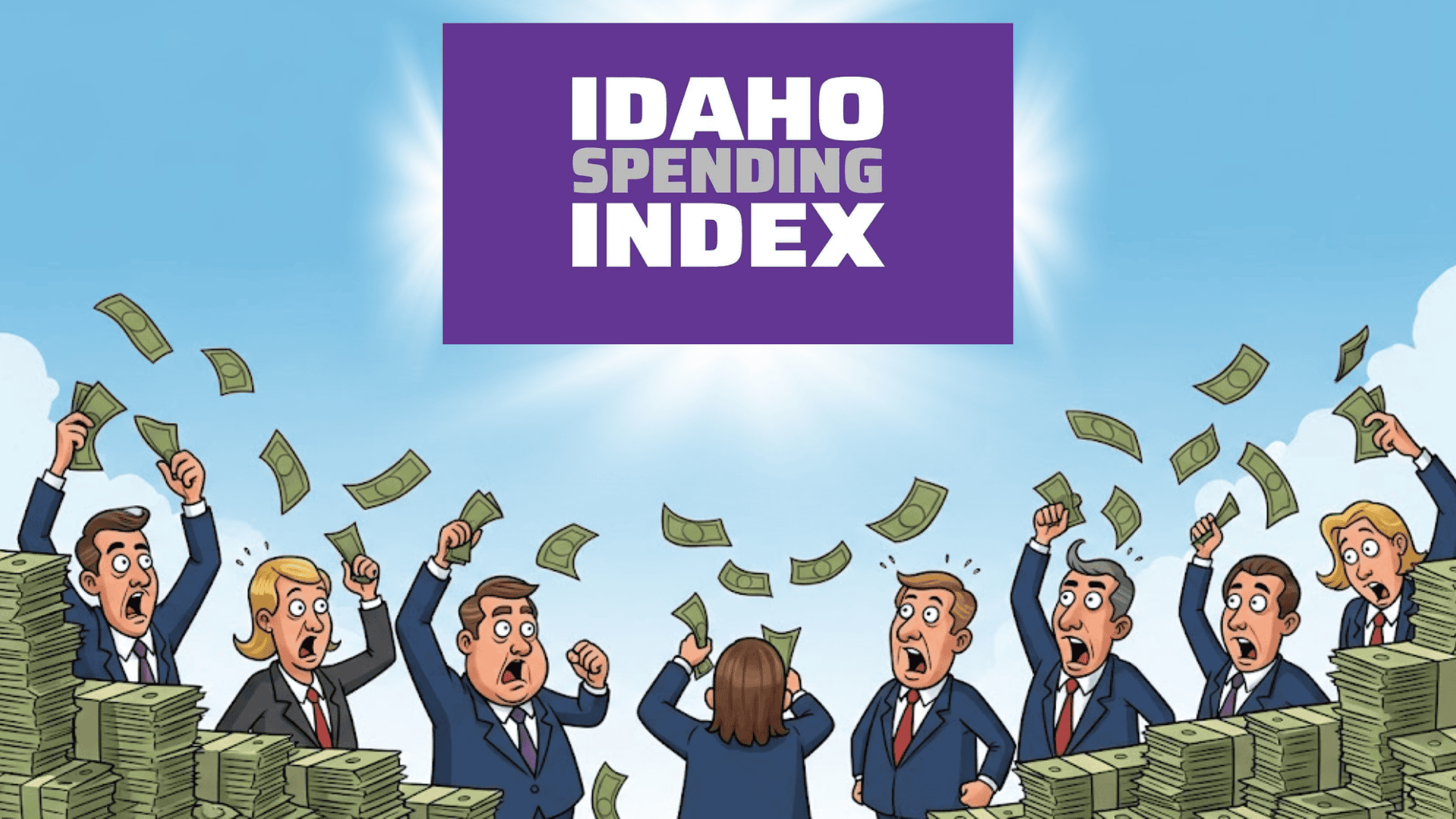



Last week’s kickoff of the Idaho DOGE Task Force highlights the need to rein in Idaho’s spending growth. It’s a tall order. Since 2019, the Idaho Freedom Foundation’s Spending Index has been the only yardstick for measuring the impacts of individual agency appropriations bills. And necessarily, the votes on these bills by legislators provide the only window into who supports excessive spending and who opposes it.
As we have noted in past articles, Idaho’s all-funds budget (meaning state and federal dollars appropriated by the Legislature) has increased 55% from Fiscal Year 2020 (FY20) to FY25. That is, from $8.96 billion to $13.89 billion in just five years! We are not including the current year, FY26, because it is still unclear how much spending has increased, as some of the spending (the exact amount is unknown) was moved “off-budget,” as we have noted.
It would be hard to argue that supporting this outrageous spending growth can be squared with claiming the mantle of fiscal conservatism. And yes, Idaho as a state is growing, but the increase in population plus inflation over the same time period does not come close to the government spending growth approved by the Legislature. The spending growth is about 60% greater than the population plus inflation.
The Idaho Freedom Foundation calculates and publishes an annual Spending Index that compiles votes on all the consequential budget bills. Because our Spending Index highlights this massive spending growth and the legislators who vote for most of it, we have been subject to criticism and confusion about what the Spending Index does.
The misunderstanding of the Spending Index is echoed in a claim by columnist Brian Almon. In a recent article, he stated, “The highest-scoring lawmakers were those who voted against nearly every budget. That’s fine if you believe the budgets are too large, but those scores can’t measure the painstaking work of combing through budgets line by line to find cuts, or recognizing when a budget is the best realistic option.”
This quote actually gets both the budget process wrong and the Spending Index structure wrong. First, the budget process is bifurcated into votes on packages of approximately 10 maintenance budgets, followed by separate votes on agency-specific enhancement (growth) budgets. For the growth budgets there are over 80 bills.
In truth, legislators could vote in favor of 91% of the total budget appropriation dollars (all the maintenance budgets) and still get a 100% score on the Spending Index. Here’s why.
The maintenance budgets were all rated neutral on our Spending Index. Since maintenance budgets combine the spending of multiple agencies into one bill, it would have been difficult to assess each one and then blend the scoring points; therefore, we opted for neutrality. For example, Senate Bill 1110, a maintenance bill for the General Government, combined the Department of Administration, Office of the Governor, and the Department of Revenue and Taxation all into one budget bill.
But there is a more salient issue. The maintenance budgets were based on last year’s ongoing spending (with some very small adjustments) plus the following: new benefit costs, pay raises, contract inflation, and agency cost allocation changes. If this sounds like a big list, keep in mind that the pay and benefit increases were over 95% of the cost bridge from last year’s (FY25) ongoing spending to this year’s (FY26) maintenance budget.
And no legislator was penalized for voting for or against these maintenance budget bills because maintenance budgets are essentially constructed for keeping the lights on and doors open in the current operations of state agencies. They totaled $12.85 billion out of a total final appropriation of $14.10 billion, meaning 91% of the budget.
An interesting side note, only one legislator voted against all of the maintenance budgets, the liberal Democrat from Boise, Representative Berch. Why? Because he was bitter about the new budget process, his votes expressed his displeasure. A smattering of Republicans voted against maintenance budgets, the most being 11 “no” votes on the biggest maintenance budget of all, for Health & Welfare, reflecting the mammoth growth of Idaho’s welfare state.
With respect to the enhancements — e.g., replacement items, population adjustments, and new spending — they add about $1.25 billion to the maintenance budget totals. And these “government growth” budgets are the focus of our Spending Index in tracking legislator votes.
In what universe, after spending has increased 55% in the prior five years, would a call for spending another $1.25 billion on top of the maintenance budget of $12.85 billion not deserve scrutiny?
So, a legislator could vote for all of the maintenance budgets and about $9 million of the enhancement budgets (some scored neutral) and get a perfect score. That would be voting for funding 91% of the final appropriations, resulting in an overall cut of 7.4% compared to last year.
It hardly seems extreme to vote to cut overall spending from FY25 to FY26 by 7.4% and spend “only” $12.86 billion. Instead, as a result of the legislative process, the final actual figure was $14.1 billion. Keep in mind that pre-COVID spending, allowed to grow only at inflation plus population, would still be less than $12.86 billion.
Was IFF too miserly in its ratings for enhancement budgets and all the growth they included? Did we oppose too many? We say no. Many agencies in Idaho asked for no enhancement budgets whatsoever (according to the Budget and Policy Office). Here’s the list.
The following agencies asked for no enhancements – no new line items.
All of the remaining agencies’ budget bills that requested enhancements received either neutral or negative ratings. To rate bills with enhancements positively would imply that an agency asking for small enhancements was somehow better than those asking for none at all, as the agencies above did.
There are two other elements of Almon’s article that we take issue with. The first is the following statement: “The E in DOGE stands for efficiency, not elimination. While efficiency can and should involve spending reductions, it also encompasses consolidating agencies, streamlining processes, reducing bureaucratic friction, and breaking down silos—reforms that go beyond simply slashing budgets.”
If you visit the federal DOGE website, there is a clear theme: saving dollars, not nebulous efficiency gains. According to the website, $199 billion has been achieved in savings from the following:
“Combination of asset sales, contract/lease cancellations and renegotiations, fraud and improper payment deletion, grant cancellations, interest savings, programmatic changes, regulatory savings, and workforce reductions”
There is a massive list of contract and grant cancellations, and while federal DOGE has fallen well short of Elon Musk’s original savings projections, he gets kudos for heading right into the federal Payment Management System to review where the dollars are going. And we agree with Almon that streamlining processes and consolidating agencies can be worthwhile, but the principal yardstick is still dollars saved. In fact, one of the reasons the term efficiency rolls so easily off the tongues of state agencies is that it is often a cloaking device for more spending with no mandated savings.
Finally, Almon states that voting against budgets and getting high Spending Index scores “can’t measure the painstaking work of combing through budgets line by line to find cuts, or recognizing when a budget is the best realistic option.” We have news for everyone. JFAC itself does not comb through all budgets line by line. Generally, only new or changed budget requests receive such treatment, with some notable exceptions, like the Public Health Services budget. The legislative budget book, even at over 850 pages, does not provide a line-by-line review of the base budget at all. The base (prior years’ ongoing spending) budget of $12.61 billion is 89% of the total appropriations of $14.1 billion, and the public can’t easily see what all that includes. The current JFAC leadership is pressing ahead to provide a comprehensive way to review the base spending.
We can certainly sympathize with the “mid-range Spending Index scores” of some JFAC members who decided that supporting some savings in exchange for voting for smaller, but still growing budgets, was a legitimate trade-off. But this is a strategy without a clearly defined objective. A specific objective would be one that held the overall growth of spending to a fixed percentage increase — a growth ceiling.
The Idaho Freedom Foundation’s Spending Index is perhaps the only indicator of how legislators vote compared to fiscally conservative ideals. It is a tested system with a clear feedback loop. This is demonstrated by the consistently low average scores for the Legislature, essentially an inverse of the excessive spending growth. The Legislature’s average Spending Index score was 38% for 2025, an improvement from the 2020 to 2025 average of 34%. But the Legislature is still approving way too much spending. Period.
We will have more to say on this in future articles.

